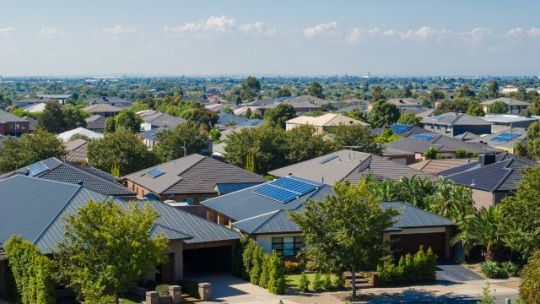Victorian Homebuyer Fund to help residents buy a home with a low deposit

There’s new funding in Victoria that will help around 3,000 aspiring homeowners buy a house that would be part-owned by the government. You just need to have a deposit of between 3.5-5% and meet the eligibility criteria.
What is the Victorian Homebuyer Fund?
The Victorian Homebuyer Fund (VHF) is a $500 million fund that’s open to eligible people in the state to help them buy a house.
It’s a shared equity scheme, meaning the Victorian Government makes a financial contribution to the purchase price of a home, which it then part-owns in the form of a proportional interest, or share, in the property. Homebuyers can buy back the Government’s share in the property over time through refinancing, using their savings or upon sale of the property.
According to the Victorian State Revenue Office, eligible homeowners could start with a 5% deposit and receive a contribution from the government of up to 25% towards the purchase price of the property they buy. Aboriginal and Torres Strait Islander homebuyers who are eligible for the funding could receive support with at least a 3.5% deposit, and the government would then provide a contribution of up to 35%.
The scheme is backed by two participating lenders, Bank Australia and Bendigo Bank, and the Victorian Government indicates the provisional application process for the VHF will be handled through them.
The funding is available in addition to possible land transfer duty (also known as stamp duty) exemptions/concessions and First Home Owner Grants that may be an option depending on eligibility.
Who is eligible for the funding?
To be eligible to participate in the VHF, the Victorian Government says you need to meet all of the following criteria:
- Be an Australian citizen or permanent resident, and be at least 18 years of age at settlement
- Have saved the required minimum deposit (at least 5% or 3.5% depending on your circumstances) of your chosen property’s purchase price
- Earn $125,000 or less per annum for individuals, or $200,000 or less per annum for joint applicants. This refers to your gross annual income
- Occupy the purchased property as your principal place of residence
- Be a natural person (that is, not an organisation, company, trust or other body or entity)
- Not purchase your property from a vendor who is a related person (such as a relative)
- Not own an interest in any land at the time of purchase (including as trustee of a trust or beneficiary under a trust)
- Not be a shareholder in any corporation (other than a public company) that owns any land.
Based on these criteria, you don’t necessarily have to be a first homebuyer to be eligible, but you can’t currently own a property.
Where can you purchase a property, and what type, with the funding?
Aspiring homebuyers can’t purchase the property just anywhere they like, but need to buy in either Metropolitan Melbourne, Geelong or an eligible regional location such as Ballarat or Bendigo. The full list of eligible locations is on the Victorian Government’s website.
The property needs to be an existing or new house, townhouse, unit or apartment, so vacant land and off-the-plan properties are not eligible for the funding.
The maximum purchase price under the VHF must be $950,000 or less in Metropolitan Melbourne and Geelong, or $600,000 or less in other eligible regional locations.
How to apply for the Victorian Homebuyer Fund
- Check your eligibility.
- Check the eligibility of the property you wish to buy.
- Gather supporting documentation for the lender, which may include identification such as your passport or driver’s licence, as well as payslips and details of expenses.
- Speak with a participating lender – Bank Australia or Bendigo Bank – or contact the government if you have more questions on (03) 7020 1549, 8.30am to 5pm AEST, Monday to Friday, excluding public holidays. If you receive provisional approval, proceed to step 5.
- Find a property and enter a contract of sale within six months of receiving provisional approval for the VHF.
- Complete settlement of your property, which the Government recommends doing with the assistance of a lawyer or conveyancer.
More details on how to apply can be found on the Victorian Government’s page on applying for the VHF.
The comparison rate for all home loans and loans secured against real property are based on secured credit of $150,000 and a term of 25 years.
^WARNING: This comparison rate is true only for the examples given and may not include all fees and charges. Different terms, fees or other loan amounts might result in a different comparison rate.
 Owner occupied
Owner occupied
 20% min deposit
20% min deposit
 Redraw facility
Redraw facility
Canstar may earn a fee for referrals from its website tables, and from Sponsorship or Promotion of certain products. Fees payable by product providers for referrals and Sponsorship or Promotion may vary between providers, website position, and revenue model. Sponsorship or Promotion fees may be higher than referral fees. Sponsored or Promoted products are clearly disclosed as such on website pages. They may appear in a number of areas of the website such as in comparison tables, on hub pages and in articles. Sponsored or Promoted products may be displayed in a fixed position in a table, regardless of the product’s rating, price or other attributes. The table position of a Sponsored or Promoted product does not indicate any ranking or rating by Canstar. For more information please see How We Get Paid.
This article was reviewed by our Sub Editor Tom Letts before it was updated, as part of our fact-checking process.

The comparison rate for all home loans and loans secured against real property are based on secured credit of $150,000 and a term of 25 years.
^WARNING: This comparison rate is true only for the examples given and may not include all fees and charges. Different terms, fees or other loan amounts might result in a different comparison rate.
 Owner occupied
Owner occupied
 50% min deposit
50% min deposit
 Redraw facility
Redraw facility
Try our Home Loans comparison tool to instantly compare Canstar expert rated options.
The comparison rate for all home loans and loans secured against real property are based on secured credit of $150,000 and a term of 25 years.
^WARNING: This comparison rate is true only for the examples given and may not include all fees and charges. Different terms, fees or other loan amounts might result in a different comparison rate.





